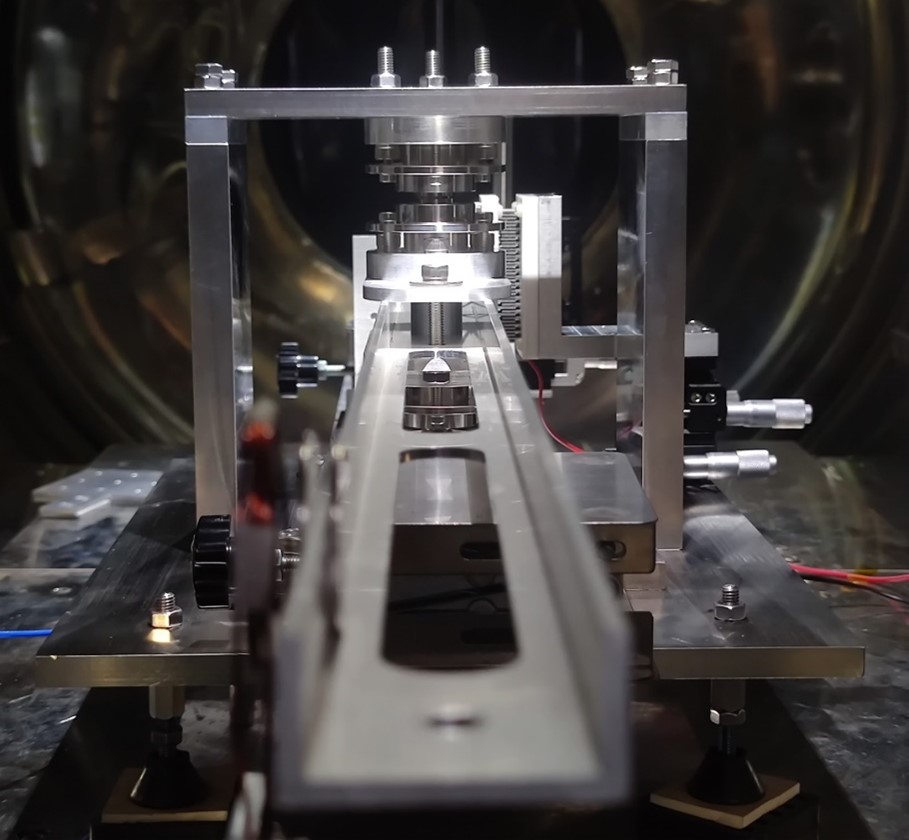Our research
Micro-thrust measurement
Thrust is the main expression of the performance of all electric propulsion systems, today’s electric propulsion system to generate thrust is the main principle of Newton’s second law, that is, the electric thruster through the electric, magnetic, thermal and other acceleration effects of the particle from the thruster exit at high speed, in the thruster exit plane to complete the exchange of charged particle momentum, and ultimately the overall momentum change of the particle determines the magnitude of thrust.
Since the thrust of electric thrusters is small (only in the order of micro Newtons to Newtons), it is usually necessary to use sensitive elements such as pivots, suspension wires, and magnetically levitated stages to amplify the mechanical effects of the operation of electric thrusters, followed by precision sensors to measure the kinematic characteristics of the force measuring stage or its force characteristics.

Principle of a torsional pendulum thrust measurement device
In our laboratory, several micro-thrust measurement devices have been designed and developed with direct or indirect measurement principles, ranging from micro-Newtons to Newtons, to accurately measure the thrust values of different types of micro-thrusters.

Micro thrust stand with sub-micro Newtons thrust resolusion
In MagnetoPlasmaDynamic Thruster (MPDT), Variable Specific Impulse Magnetoplasma Rocket (VASMIR), etc., the common thrust measurement method for those thrusters is the target method. And the target method is an indirect thrust measurement method, i.e., measuring the plume flow generated by the thruster to estimate the thrust value of the thruster, which has the advantages of simple installation, convenient measurement, not being affected by the weight of the thruster and the influence of power and liquid supply pipelines.

Indirect Thrust target for MPDT and VASMIR thrusters
Featured articles:
[1] Hai-bin Tang, Xin-ai Zhang, Yu Liu, Hai-xing Wang, and Chen-bo Shi, “Experimental Study of Startup Characteristics and Performance of a Low-Power Arcjet”, Journal of Propulsion and Power, Vol. 27, No. 1, 2011, pp. 218-226
[2] Shi, C. B., Tang, H. B., Zhang, X. A., Qin, C. J. and Cao, X. W., “Static Characteristics of a mN Range Thrust Stand and Uncertainty Analysis of Thrust Measurements,” Journal of Solid Rocket Technology, Vol. 3, 2011, pp. 398-402 (In Chinese)
[3] Tang Haibin, Shi Chenbo, Zhang Xin’ai, Zhang Zun, Cheng Jiao. “Pulsed thrust measurements using electromagnetic calibration technique”. Review of Scientific Instruments, Vol. 82, No.035118 (2011).
[4] Wang, B., W. Yang, H. Tang, Z. Li, A. Kitaeva, Z. Chen, J. Cao, G. Herdrich, and K. Zhang. “Target thrust measurement for applied-field magnetoplasmadynamic thruster.” Measurement Science and Technology 29, no. 7 (2018): 075302.
[5] Zhang, Zhongkai, HANG. Guanrong, QI. Jiayun, Zun Zhang, Zhe Zhang, LIU. Jiubin, YANG. Wenjiang, and TANG. Haibin. “Design and fabrication of a full elastic sub-micron-Newton scale thrust measurement system for plasma micro thrusters.” Plasma Science and Technology 23, no. 10 (2021): 104004.
(Lastly Updated in September, 2022
